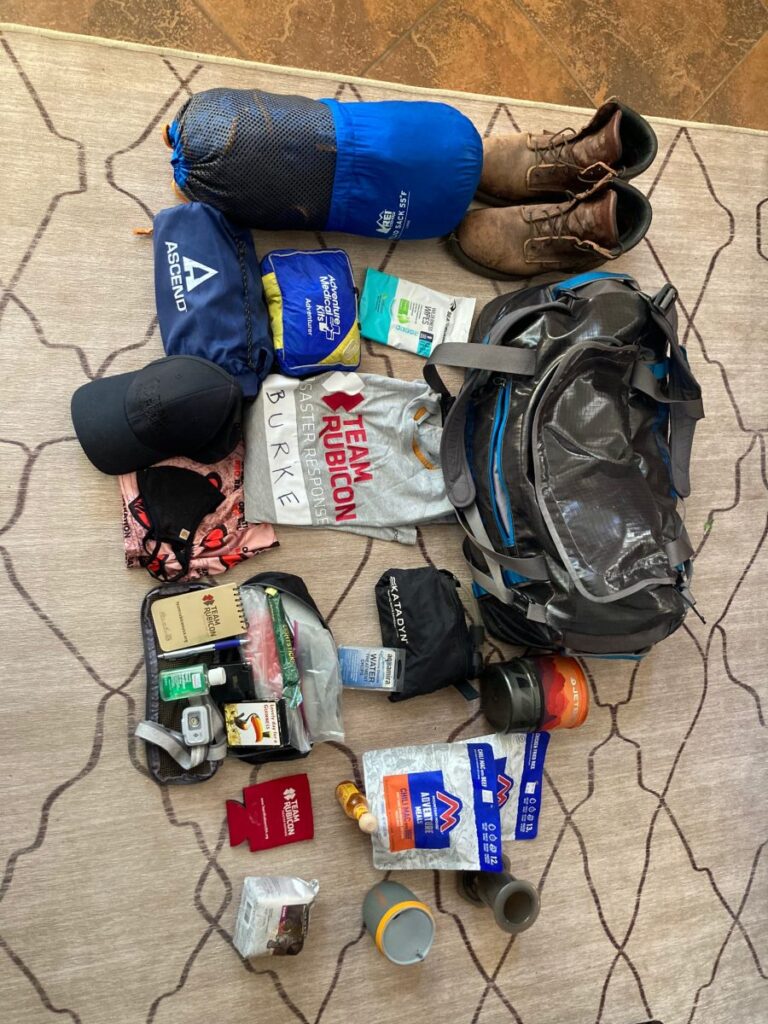Whether they’ve served in the military, for FEMA, or for years as a disaster relief volunteer, the people who know disasters best in Team Rubicon also know how to pack their own disaster prep kits, and why they are critical. Here’s a peek inside three disaster kits, with maybe a few ideas of what to put in your own emergency kit.
Jeff Byard: A Man with a Load Test Plan
Jeff Byard is a longtime emergency management professional who left FEMA and joined Team Rubicon as VP of Government Relations and Emergency Management in 2020. Given all of the disasters he has helped state and national governments respond to, he should know a bit about preparedness.
“There is no question, people who take the time to have a plan and prepare are in a better position for recovery,” said Byard.
Byard is so prepared, he even has an exit plan drawn up, and a location to go to should he and his family need to evacuate.

3 boxes of assorted non-perishable food
Water
2 weather radios that don’t need batteries
2 first aid kits and all necessary medicine in a waterproof/fireproof case that is a grab-and-go
A backup generator that gets load-tested for 5 minutes every Wednesday
$400 emergency cash on hand
Always keep at least half a tank of gas in both cars
Necessary items for personal and family protection
David Burke Packs the Heat
Much of what’s in Team Rubicon’s SVP of Programs and Operations David Burke’s disaster kit doubles as camping gear he admits. That’s because in Durango, CO, many things he’d need in a disaster are interchangeable with what he’d need in the woods. What he might not have in the backcountry, however, is the cans of non-perishable food.
And also:
Warmth: I live in Colorado and the winters get cold. Disasters frequently bring long power outages, sleeping bags plus pads to keep you warm and off the ground should you be required to be outside. Also, plenty of warm synthetic clothing that keeps warmth even when wet—you never know exactly what conditions you’ll face post-disaster.
Light: I keep a headlamp in as many places as possible, along with spare batteries to ensure I can find what I’m looking for no matter the power situation. A few glow sticks come in handy to mark hazards or guide people where needed.
 Food: Plenty of non-perishable food on hand at the house—all the normal stuff you’d think of, but when it really goes sideways, backpacker food is great and every good Marine should keep Chili Mac within arm’s reach at all times. A little bottle of Cholula comes in handy, too.
Food: Plenty of non-perishable food on hand at the house—all the normal stuff you’d think of, but when it really goes sideways, backpacker food is great and every good Marine should keep Chili Mac within arm’s reach at all times. A little bottle of Cholula comes in handy, too.
Water: Several gallons of water on standby will keep you and yours hydrated and come in handy should you need it to clean any wounds or injuries. I also keep multiple means to “treat” water, including a house stove and a camping stove (with plenty of fuel) for boiling water, a charcoal water purifier, and a chemical purifier to ensure dehydration isn’t something we need to worry about while all else is not working right.

Pat Gustafson is Three Levels of Prepared
Pat Gustafson is a U.S. Army veteran and long time Greyshirt who lives in Wyoming. Her emergency kit doesn’t fit neatly in one bin, it fills a wall.
“I have a disaster shelf unit! It can be hastily packed or grabbed to go or I can use it for my family and friends in place,” explains Gustafson. “I don’t consider myself a preppier. But I am prepared to take care of me and mine.”
Bottom shelf (including, but not limited to): Camping gear: Sleeping supplies, including heavy and lightweight bags, blankets and sheets, pillows, an inflatable air mattress, and electric/ battery inflator pump, a hammock, a large plastic tarp with grommets, 50 ft coil of nylon rope (pink) and 30 ft coil of paracord (pink), tent stakes, tent poles, a small tool kit, disposable Mylar survival blankets, four 6” taper candles; two cans of Sterno; two lighters, and a package of waterproof stick matches, plus a solar lantern.
Middle shelf: All the medical supplies a pop-up medical center might need.
Top shelf: Team Rubicon Gear. Here’s where I keep my Go Bag supplies—everything from Ziploc bags to multiple pairs of boots and that one outfit I can throw one and look civilized if we leave the forward operating base—or when we head home. Plus, a dog leash, dog bones, and a harmonica.



